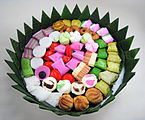Kaasstengels
 Kaasstengels in Indonesia | |
| Alternative names | Kastengel, kue keju |
|---|---|
| Type | Cookie |
| Place of origin | Netherlands and Indonesia |
| Main ingredients | Flour, maizena, baking powder, egg yolks, butter or margarine, salt, sugar, cheddar cheese |
Kaasstengels (// ⓘ), Kastengel or kue keju is Dutch-Indonesian cheese cookie in the form of stick, commonly found in the Netherlands and Indonesia. The name describe its ingredients, shape and origin; kaas is Dutch word for "cheese", while stengels is also Dutch word for "stick". Unlike most cookies, kaasstengels taste savoury and salty instead of sweet.[1] In Indonesia, owed to its colonial links to the Netherlands, kaasstengels, together with nastar and kue putri salju are the popular kue kering (dried kue or cookie) during festive occasion, such as Natal (Christmas) and Lebaran (Eid al Fitr).
Kaastengels on the other hand, refer to Dutch hapjes (snacks) of "cheese-fingers", derived from Dutch kaas (cheese) and tengels (fingers). It is a small spring roll or loempia-like crepes of the size of a finger, filled with gouda or edam cheese, which have been deep fried and served with a small bowl of a spicy chili sauce.[1]
Ingredients and baking method
The cookie's dough is made of the fine mixture of butter (or margarine), egg yolks, with addition of grated matured cheese, then mix it together with flour, maizena and baking powder. The dough the are rolled into small rectangles about 1x3 cm. Preheat the oven to 180°C, then place the cheese cookie rectangles onto greased trays. Brush each one with the egg yolk and sprinkle with grated cheddar. The kaasstengels are baked until done about 15 minutes.[2]
See also
References
- ^ a b "Kaastengels, kaasstengels & the dutch love for snacks". Me Utrecht Barcelona.
- ^ "Kaastengels (Cheese Shortbread)". Food.com.

